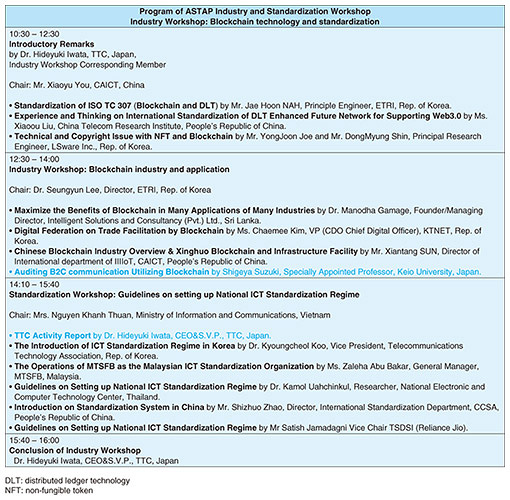 |
|||||||||||
|
|
|||||||||||
|
Global Standardization Activities Vol. 20, No. 9, pp. 81–84, Sept. 2022. https://doi.org/10.53829/ntr202209gls Report on the 34th Asia-Pacific Telecommunity Standardization Program MeetingAbstractThe 34th Asia-Pacific Telecommunity Standardization Program meeting (ASTAP-34) was held from 18 to 22 April 2022. This meeting was held in an online format due to the impact of the spread of novel coronavirus infections and was attended by approximately 230 participants (registered) from 19 Member States. This article reports on ASTAP-34 and the Industry Workshop held in conjunction with ASTAP-34. Keywords: APT, ASTAP, standardization 1. IntroductionThe Asia-Pacific Telecommunity (APT) is an international organization promoting development in the field of information and communication technology (ICT) in the Asia-Pacific region and was established in 1979 with 38 Member States in the Asia-Pacific region [1]. The APT Standardization Program (ASTAP) is a conference promoting standardization activities in the APT region and was established in 1998 [2]. The main objectives of ASTAP are 1) to build a cooperative and collaborative system for standardization in the APT region and contribute to international standardization; 2) train standardization practitioners in the APT region and support skill development in the ICT field among members of the region, especially those from developing countries; and 3) make joint proposals to international standardization organizations such as the International Telecommunication Union (ITU) as a regional standardization organization. The 34th ASTAP meeting (ASTAP-34) was held from 18 to 22 April 2022 with approximately 230 participants from 19 Member States. On the first day of the meeting, the Industry Workshop on “Blockchain” and Standardization Workshop on “Guidelines on setting up a National ICT Standardization Regime” were held and attended by about 130 participants. 2. Structure of ASTAPThe structure of ASTAP and the positions held are listed in Table 1. Japan is now able to lead the discussions in each Working Group (WG) and Expert Group (EG) by serving as the Chair or Vice-Chair of each group.
3. Review of working methodsA proposal was made by the Steering Committee, consisting of the Chair, Vice-Chair, and others of ASTAP, to review the working methods for changing the title of the Chair during meetings and in documents from “Chairman” to “Chair,” from the perspective of gender equality. The working methods were thus reviewed and changed from “Chairman” to “Chair.” This was implemented from this meeting and reflected in the meeting and document amendments. There was also a request not to use the designations “He,” “She,” etc. However, it is not always possible to know all the names of the speakers in a meeting, and there are sometimes cases in which the designations “He,” “She,” “him” and “her” are used, so we need to be more aware of this. 4. Main resultsAt ASTAP-34, 19 output documents were approved, including reports of each WG. The plenary of this meeting approved two revised Terms of Reference (EG Future Network and Next Generation Networks (FN & NGN), EG Internet of Things Application/Services (IOT)), two new report documents, four liaison documents to other standardization bodies (ITU Telecommunication Standardization Sector (ITU-T) Study Group 16, ITU-T Focus Group on Autonomous Networks (FG-AN) [3], ITU-T Focus Group on AI for Natural Disaster Management (FG-AI4NDM) [4], APT Wireless Group (AWG) [5]), and one questionnaire; the two new report documents are as follows:
5. Industry WorkshopIn the ad hoc discussion on strengthening ASTAP activities held at ASTAP-33, it was agreed that the workshop at this ASTAP-34 would be an Industry Workshop in combination with a Standardization Workshop with standards developing organizations (SDOs) invited to attend. The topic of the Industry Workshop was “Blockchain,” which was carried over from the Correspondence Group planning the program of the previous ASTAP-33 workshop. The topic of the Standardization Workshop was “Guidelines on setting up a National ICT Standardization Regime,” a Work Item of the EG Bridging the Standardization Gap (BSG). Table 2 shows the program of the workshop. The Industry Workshop consisted of two sessions: Session 1: Blockchain technology and standardization and Session 2: Blockchain industry and application. Seven experts from Japan, Korea, China, and Sri Lanka gave presentations. Keio University gave a presentation from Japan. The Standardization Workshop in Session 3 was attended by SDOs from six countries: The Telecommunication Technology Committee (TTC) from Japan, the Telecommunications Technology Association (TTA) from Korea, the China Communications Standards Association (CCSA), the Malaysian Technical Standards Forum Bhd (MTSFB), Telecommunications Standards Development Society, India (TSDSI), and the National Electronics and Computer Technology Center (NECTEC) from Thailand. During the workshop, information was shared in response to the following questions raised by emerging countries that do not have a national SDO.
The schedule was tight because the workshop was held online, taking into account time differences and other time constraints, and the aim was to have as many speakers as possible share information. 6. Future plansThe APT Secretary General reported that the next meeting (ASTAP-35) would be held on site from April to June 2023, that Bangkok was currently being considered as a possible venue, and that invitations were being sought from other countries and regions. An Industry Workshop will be held independently in conjunction with the next meeting, while the Standardization Workshop will be organized by the EG BSG, with mini-workshops inviting emerging countries. References
|
|||||||||||











